Autocad Export Visible Objects to Another Drawing
Importing and Exporting CAD Files
PRO If you're a SketchUp Pro user, you can import or export CAD files, which use the .dwg or .dxf file formats.
Before you import a file, it's helpful to know what CAD entities SketchUp Pro does and doesn't support and how to prepare your CAD file for best results. Then, you can walk through the basic importing steps outlined in this article. After you're done importing, check out Starting with a CAD File in SketchUp Pro, which offers several tips and tricks for handling imported CAD geometry.
If you're exporting a SketchUp Pro file to a CAD format, how you export a CAD file depends on whether it's a 2D file, such as a floor plan, or a 3D model. In this article, you also discover how SketchUp data is exported into CAD format.
Table of Contents
- Understanding what CAD elements SketchUp can import
- Preparing a CAD file for import into SketchUp
- Importing a CAD file into SketchUp
- Understanding how SketchUp data is exported to CAD format
- Exporting a SketchUp Model as a 2D CAD file
- Exporting a SketchUp Model as a 3D CAD file
Understanding what CAD elements SketchUp can import
The following table outlines what CAD elements SketchUp does and doesn't support. If an element isn't supported, SketchUp simply ignores it when you import the CAD file.
| Supported CAD Entities | Unsupported CAD Entities |
|---|---|
| Arcs | Proprietary ADT or ARX objects |
| Circles | Dimensions |
| Entities with thickness | Hatching |
| Faces | Text |
| 3D faces | XREFs |
| Layers | |
| Lines and supported Line Styles | |
| Materials | |
| Polyline-based solids | |
| Nested blocks | |
| AutoCAD regions | |
| Point | |
| Ellipse | |
| Spline | |
| Raster Image |
Preparing a CAD file for import into SketchUp
When you take a few steps to check and prepare your CAD file before import, you can make sure all the data you need imports into SketchUp and streamline the import process. The following sections outline what you need to look for and how to resolve any potential conflicts between CAD elements and SketchUp.
Tip: You don't want to lose details in your original CAD file. Remember to create a copy of the CAD file and prepare that copy for importing into SketchUp.
Change unsupported elements
If you need to import unsupported CAD elements into SketchUp, try exploding those elements in CAD so they become primitive CAD drawing elements that SketchUp does support.
For example, when you explode CAD objects into block entities, they import into SketchUp as components. If you explode the CAD block entities into polylines, the polylines import into SketchUp as lines or polylines.
Delete unnecessary layers
In an imported CAD file, SketchUp automatically discards any entities that have no 3D relevance, such as text, dimensions, hatching, and so on. However, SketchUp won't discard the layers holding these entities. To avoid a bunch of empty layers in SketchUp, you may want to purge any unused layers through Statistics on the Model Info dialog.
Move geometry close to the origin
In SketchUp, geometry that's many miles or kilometers away from the origin (0,0) can cause performance problems. To avoid these problems, check the placement of geometry in your CAD file before you import the CAD file into SketchUp.
For example, say you're importing Autodesk AutoCAD DWG files, such as civil site plans, in order to work with the contour lines. If the graphic or geometry is far away from the origin, move it close to the origin before importing the CAD file into SketchUp.
Alternatively, deselect the Preserve Drawing Origin option in SketchUp's DWG/DXF import options, as explained in Importing a CAD file into SketchUp, later in this article.
Reduce the file size if needed
Generally, CAD files import into SketchUp successfully when the file size is 15MB or less. When you import larger CAD files, the import can take a long time or may fail. Conversely, the smaller your CAD file size, the quicker and easier the import. Also, after a complex CAD file is imported into SketchUp, you may notice that SketchUp's performance slows down. That's because lines and faces in SketchUp contain more data than their CAD equivalents.
Tip: For best results with imported CAD files, keep the size of imported files to a minimum. Here are a few tips for minimizing a CAD file before you import it into SketchUp:
- Import only the necessary geometry. SketchUp models can be designed to be as accurate as models in CAD. However, SketchUp is not designed for the same type of line-intensive drawings done in CAD software. In your CAD file, clean up or remove any content that you don't need to use after you import the CAD file into SketchUp. You might simplify the CAD file to just walls — and maybe doors and windows if you want to model those in your SketchUp file, too.
- Separate levels of detail among different CAD files. If your CAD file holds lots of necessary geometry, consider whether you break one file into a few smaller files. For example, one imported CAD file can contain site plan information, another can have a floor plan, and a final file can have a specific detail.
Check the unit of measure
If possible, find out the unit of measure used to create the CAD file. When you import the CAD file into SketchUp, you need to know whether your file uses inches, feet, or a metric unit of measurement. That way, you can match the SketchUp model's units to the CAD file's units and thus maintain the scale and dimensions of your imported CAD geometry.
In SketchUp 2018 and later, you also have the option to import the model using the units specified in the CAD file. In the Units dropdown, select Model Units from the list, which tells SketchUp to attempt to match the units saved in the CAD file. If SketchUp is unable to determine what unit of measurement was used to create the CAD file, it will default to 1 CAD unit equals 1 inch in SketchUp.
Save in a SketchUp-compatible CAD file format
When SketchUp imports a CAD file, SketchUp strips the information to its basic geometric components. So no matter what AutoCAD file format you use (such as 2013 or 2018), the end result is essentially the same. To maximize compatibility between a CAD file and SketchUp, however, saving your CAD file in the Release 13 or Release 14 format works best.
Importing a CAD file into SketchUp
After you've checked and prepared your CAD file, you're ready to import it into SketchUp. The following steps walk you through the import process for your operating system:
- In SketchUp, open the SketchUp model into which you want to import your
.dwgor.dxffile. - Select File > Import. An Import dialog box appears.
- Navigate the the place your hard drive where your CAD file is saved.
- From the Files of Type drop-down list, select AutoCAD Files (*.dwg, *.dxf).
- Select the file you want to import.
- Click the Options button. The Import AutoCAD DWG/DXF Options dialog box appears, as shown in the following figure.
- (Optional) In the Geometry area, select your preferences for the following options:
- select Merge Coplanar Faces to tell SketchUp to automatically remove triangulated lines from planes.
- Selecting the Orient Faces Consistently box tells SketchUp to analyze the direction of imported faces and orient the faces so that their direction is uniform.
- (Optional) Select the Preserve Drawing Origin checkbox to place the imported geometry at the origin defined in the .dwg or .dxf file. Leave the checkbox deselected if you want to place the imported geometry near the SketchUp origin.
- (Optional) To import geometry at the correct scale, select the unit used in your CAD file from the Units drop-down list. Your options are Model Units, Inches, Feet, Yards, Miles, Millimeters, Centimeters, Meters and Kilometers.
Tip: If you don't know the units used in the original file, select Model Units so that SketchUp turns one CAD unit into 1 inch in SketchUp. Or use a large unit type, such as feet or meters. Then you can resize the model as necessary after it's imported.
Warning: If you select a small unit, such as millimeters, but the model was originally intended to display in feet, you can unintentionally create itty-bitty faces that will be lost on import. For SketchUp to recognize a face, the face must be .001 square inches or larger.
- Click OK in the Import AutoCAD DWG/DXF Options dialog box.
- Back in the Import dialog box, click the Import button, and SketchUp Pro begins importing your CAD file.
Tip: When importing a LayOut file created using the "Export for SketchUp" feature, use the Merge Coplanar Faces option for clean imported faces.
Tip: You can also drag and drop importable files into the drawing area. After you drop the file, any relevant Import dialog box opens so you can select your desired options.
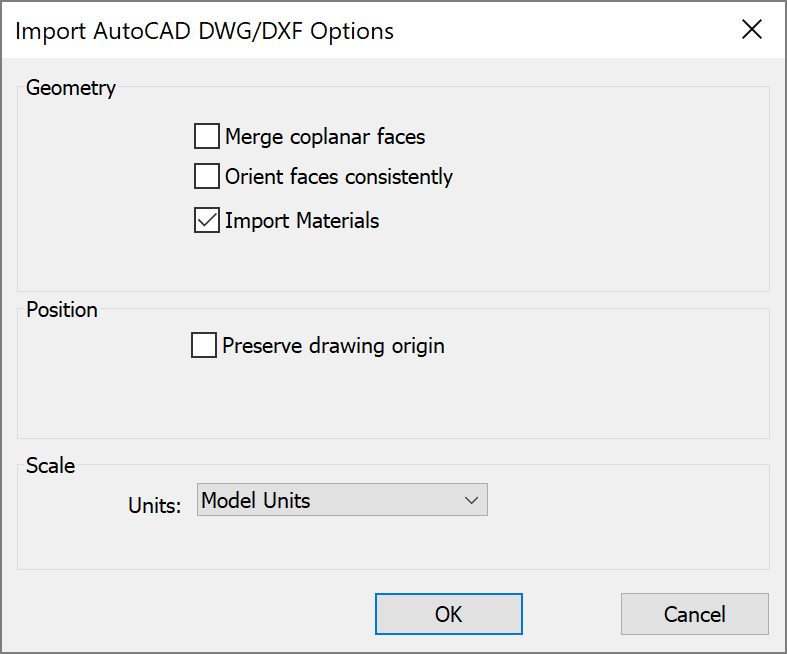
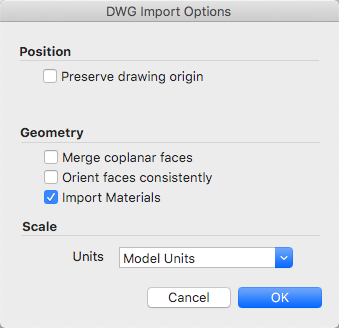
SketchUp For Web
After you've checked and prepared your CAD file, you're ready to import it into SketchUp Shop. The following steps walk you through the import process:
- In SketchUp Shop, open the SketchUp model into which you want to import your .dwg or .dxf file.
- Select the File icon (
 ). An File menu appears, select Insert
). An File menu appears, select Insert - You can select the Trimble Connect icon or the Computer icon for a local file.
- (Optional) You can also drag & drop a file from an Explorer or Finder window directly into SketchUp Shop.
- If you choose to open the file locally, navigate to the place on your hard drive where your CAD file is saved.
- Select "All Files" as the desired format.
- Select the file you want to import.
- The Import AutoCAD DWG/DXF Options dialog box appears, as shown in the following figure.
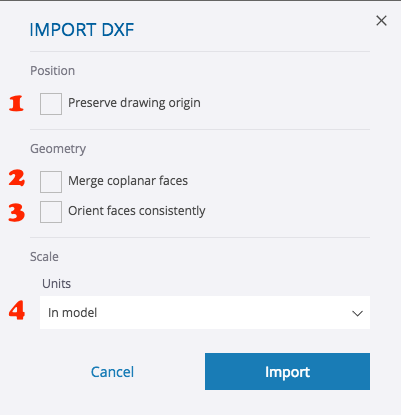
- (Optional) Select the Preserve Drawing Origin (#1 Above) checkbox to place the imported geometry at the origin defined in the .dwg or .dxf file. Leave the checkbox deselected if you want to place the imported geometry near the SketchUp origin.
- (Optional) In the Geometry area, select Merge Coplanar Faces (#2 Above) to tell SketchUp to automatically remove triangulated lines from planes. Selecting the Orient Faces Consistently (#3 Above) box tells SketchUp to analyze the direction of imported faces and orient the faces so that their direction is uniform.
- (Optional) To import geometry at the correct scale, select the unit used in your CAD file from the Units drop-down list (#4 Above). Your options are Model Units, Inches, Feet, Yards, Miles, Millimeters, Centimeters, Meters and Kilometers.
- Click Import begin the import process.
Tip: If you don't know the units used in the original file, use a large unit type, such as feet or meters. Then you can resize the model as necessary after it's imported.
Warning: If you select a small unit, such as millimeters, but the model was originally intended to display in feet, you can unintentionally create itty-bitty faces that will be lost on import. For SketchUp to recognize a face, the face must be .001 square inches or larger.
Tip: If you have a floor plan or other vector graphics in an Adobe Illustrator (.eps) file, you can export the .eps file to .dwg or .dxf format in Illustrator. Then import the vector graphics following the preceding steps. If, in Adobe Illustrator, you first reduce the number of anchor points that define curves, you can improve the file's performance in SketchUp. In particular, when you extrude faces from curves that contain lots of line segments, the SketchUp file size can increase dramatically.
Understanding how SketchUp data is exported to CAD format
Before you export a SketchUp model to a CAD file format (.dwg or .dxf), you may find it helpful to understand how SketchUp data is translated into the CAD format that you choose. Here's what you need to know:
- SketchUp faces are exported as a triangulated polyface mesh with interior splframe hidden lines (if applicable). This conversion helps to simulate the appearance of your SketchUp file, even when all exported faces are triangular.
- SketchUp uses the current units set in the Units pane of the Model Info dialog box as a reference for translation to a
.dwgor.dxffile. For example, if the current Model Info unit setting is Decimal and Meters, then AutoCAD must be set to decimal for the units to translate correctly as meters when you open the exported file in AutoCAD. - Duplicate line entities aren't created on top of a p-line entity.
Exporting a SketchUp Model as a 2D CAD file
When export your model view as a 2D CAD file, you can choose the scale and a number of line options. The result is a 2D vector file in .dwg or .dxf format that you can open in your CAD program.
Follow these steps to export a 2D CAD file:
- To maintain your model's scale in the exported file, in SketchUp, select Camera > Parallel Projection. Then set your view to one of SketchUp's standard views by selecting Camera > Standard Views and selecting an option from the submenu that appears. (See Viewing a Model for details about the model view options.)
- Select File > Export > 2D Graphic.
- Navigate to the place where you want to save your exported file.
- (Optional) Change the file name if you'd like to name the exported file something other than the SketchUp file's current name.
- Select either the
.dwgor.dxffile type. In Microsoft Windows, select this option from the Save As Type drop-down list. On a Mac, use the Format drop-down list. - Click the Options button to set the scale and line options, which are explained in detail in the upcoming list. When you're done, click OK in the DWG/DXF Hidden Line Options dialog box (Microsoft Windows) or the Export Options dialog box (Mac OS X).
- Click Export and your CAD file is saved in your selected location.
In the following figure, you see the line options dialog box for your current operating system. The following list introduces your options so that the lines in your exported file meet your needs:
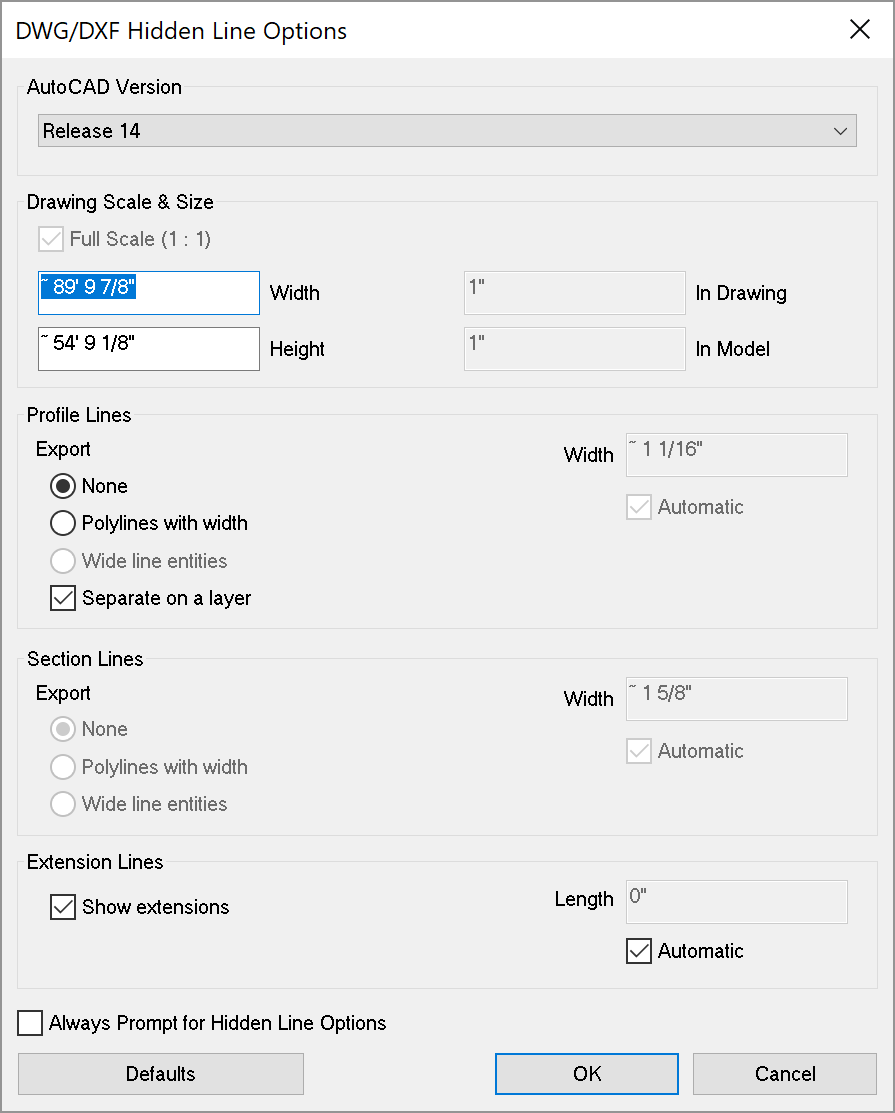
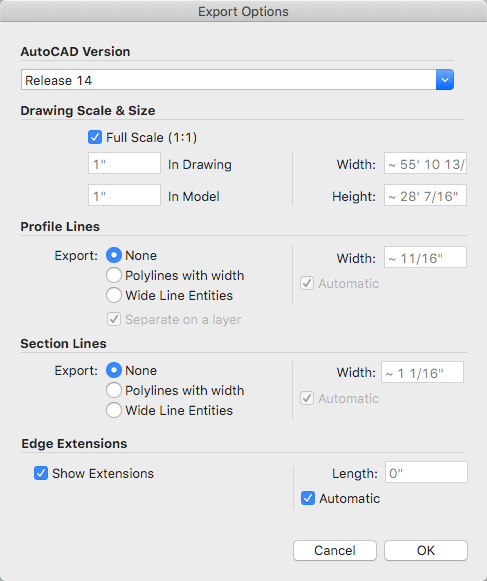
- AutoCAD Version: Select what version of AutoCAD you'd like to use to open the exported file.
- Drawing Scale & Size: The Full Scale checkbox is selected by default. However, if you deselect that checkbox, you can set a custom scale. In the In Drawing box, type the actual measurement you want to use to set your scale. In the In Model box, type the value for scaling your exported model. For example, for a scale of 1:4, type 1' in the In Model box and 4' in the In Drawing box.
- Profile Lines: Here, you can customize how profile lines appear in your exported file. You can set the line width as follows:
- Select None to export profile lines at the standard width.
- Select Polylines with Width to export profile lines as AutoCAD polylines. When you select this option, you can leave Automatic selected so that the exported lines match the profile line width. If you deselect Automatic, you can enter a custom width in the Width box.
- Select Wide Line Entities to export profile lines as AutoCAD wide line entities.
The Separate on a Layer checkbox, which is selected by default, creates a layer for profile edges. If you've used SketchUp layers to control visibility, note that SketchUp layer assignments don't translate directly when you export a SketchUp file to a 2D CAD file. - Section Lines: If you export section lines or a section slice, these export options become available. See Slicing a Model to Peer Inside for details about sections and how to export them.
- Edge Extensions: Some CAD applications might have problems recognizing line endpoints and intersections when your model uses SketchUp line extensions. Deselect the Show Extensions checkbox to toggle extensions off in your exported file. If you leave Show Extensions selected and deselect the Automatic checkbox, you can enter an exact length for line extensions in the Length box.
In Microsoft Windows, you can select the Always Prompt for Hidden Line Options if you'd like to set options in this dialog box anytime you export a 2D CAD file. You can also restore the default settings by clicking the Defaults button.
Exporting a SketchUp Model as a 3D CAD file
When you export a SketchUp model as a 3D CAD file, you can select what entities are exported. To export your model, follow these steps:
- In SketchUp, select File > Export > 3D Model. The Export Model dialog box appears.
- Navigate to the location where you want to save your exported file.
- (Optional) Change the file name if you like. By default, the exported file uses the same name as your SketchUp file name.
- Select either
.dwgor.dxfas the file format for your exported file. In Microsoft Windows, select your file type from the Save As Type drop-down list. In Mac OS X, use the Format drop-down list. - Click the Options button to open the Export Options dialog box, shown in the following figure. From the AutoCAD Version drop-down list, select the version of AutoCAD you'd like to use to open the exported file. In the Export area, select the checkbox for each type of entity that you want to include in the exported file. Click OK when you're done.
- Back in the Export Model dialog box, click Export, and your file appears in the location where you chose to save it.

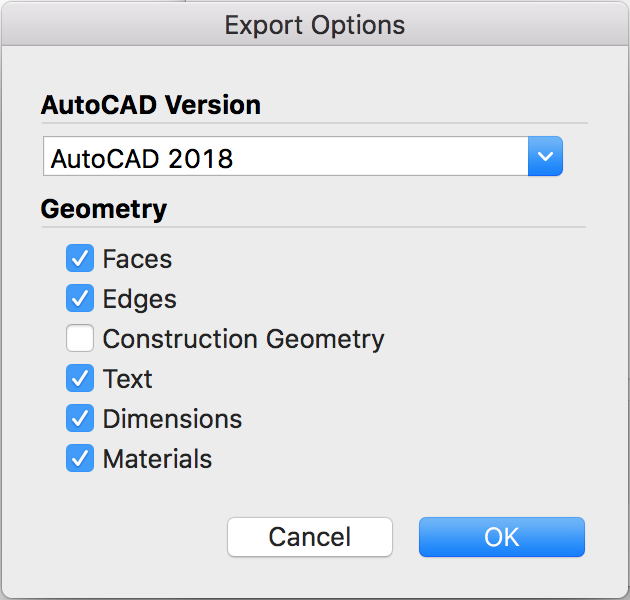
Tip: Export and Import with materials for better BIM interoperability and workflows using the .dwg format.
Source: https://help.sketchup.com/en/sketchup/importing-and-exporting-cad-files
0 Response to "Autocad Export Visible Objects to Another Drawing"
إرسال تعليق